Public Works
- Address: 1099 Royalsborough Road, Durham, ME 04222
- See map: Google Maps
- Email: publicworks@durhammaine.gov
- Phone: 207-353-3281 (Public Works Garage)
- Fax: 207 - 353-3283
Jump To…
- Road Commissioner
- Household Waste Disposal Options
- Helpful Links
- Mission Statement
- Winter Operations
- Winter Equipment
- Winter Sand Pile
- Restricing Vehicle Weight on Posted Ways
Road Commissioner
Road Commissioner - Calvin Beaumier
- Email: publicworks@durhammaine.gov
- Phone: 207-844-1774 (Road Commissioner)
Household Waste Disposal Options:
- Environmental Depot - Lewiston, Maine
- Fluorescent Light Bulbs (Recycle at Gilman Electric, Auburn, Maine)
- Maine Waste to Energy
- Paint Care (accepts paint for recycling at no charge)
- Riverside Recycling
- Weekly Resident Trash Collection Schedule
Helpful Links:
(Back to top)Mission Statement
The Durham Public Works Department is committed to providing exceptional public service in a prompt, courteous, safe, efficient and cost-effective manner. Durham Public Works strives to plan, build, improve and maintain Durham’s public infrastructure in a manner respectful of the environment and to enhance the quality of life of the citizens of Durham.
Guiding Principles
- To provide a safe and reliable roadway system in the most efficient manner with available funding;
- To provide quality service by striving to provide maintenance levels necessary to achieve public satisfaction;
- To ensure that projects will provide functional and economic benefits through responsible expenditure of funds.
Winter Operations
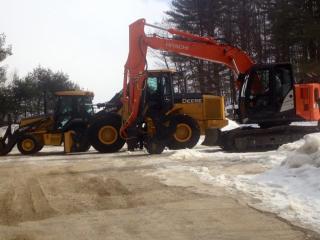
The Public Works Department is committed to providing the safest possible roads as cost efficiently as possible.
We communicate with Durham Fire & Rescue and will plow ahead of emergency vehicles to ensure a timely response. If you have an emergency and your road has accumulated snow, we will be there as soon as possible to clear the way.
The Department does its best to plow without any damage to mailboxes, but it happens sometimes. If your mailbox is damaged by Durham winter plow trucks, please read our mailbox policy.
(Back to top)Winter Equipment:
- Six (6) tandem axle dump trucks equipped with plows wings & material spreaders;
- Two (2) one ton dump trucks equipped with plows & material spreaders;
- One (1) ¾ ton pick up truck equipped with plow;
- Wheel loader;
- Loader backhoe;
- Back up tandem axle plow truck equipped with plow, wing & material spreader.
Before the Storm
- Beginning in September the Department begins prepping for the upcoming winter. Tasks such as a comprehensive inspection of every piece of equipment from front to back, calibrating the spreaders, driving the plow routes for operator familiarity and hazard identification and procuring anti icing products and parts stock keep us very busy this time of year.
During the Storm
- One of the most important steps in dealing with winter storms is “pretreating” the roads. Pretreating is what you see when the trucks are on the road just prior to or at the start of the storm and is referred to “anti icing”. These trucks are usually applying a light amount of salt and salt brine. Pretreating in this manner creates a salt brine barrier between the snow and the road keeping the snow from bonding to the surface and allowing us to achieve safe bare roads sooner, this process less costly than trying to melt off snow and ice pack after the storm. Once the snow has bonded to the road surface we have to enter into a costly “de-icing” operation.
- The Department then begins its plowing routine, this generally begins as soon as accumulation starts and continues until the roads are clear and free of ice and snow. We concentrate our efforts on our main roads, which in Durham are roads such as Royalsborough Road, Newell Brook Road, Pinkham Brook Road, Hallowell Road, Swamp Road, Soper Road, Quaker Meetinghouse Road, Rabbit Road, Runaround Pond Road, Davis Road, Bowie Hill Road, Stackpole Road and Auburn Pownal Road. It is essential for the mobility of emergency vehicles as well as the public to keep the main roads as clear as possible. We continue plowing in this pattern for the duration of the storm making rounds on the secondary subdivision roads as needed.
- Once the storm subsides we begin our “cleanup” operation. This usually consists of a final salt treatment to break up any remaining snow or ice, cleaning up intersections, and then scraping the slush of the road. The sooner we clear the road of moisture the sooner it can dry which helps to mitigate dangerous refreezing and costly “call backs”.
- Each storm is different and presents challenges that can be difficult to handle. Things such as temperature, time of day, traffic conditions, rate of snowfall and type of snow are just some of the factors affecting the impact of a storm. The amount of snowfall alone can be deceptive. For example, a small storm during the weekday commute can cause major problems, while a similar storm on the weekend or late at night may cause little trouble. Light snow and heavy winds can cause additional drifting and ice buildup. Heavy wet snow will bring down trees and power lines creating a different set of problems as well as additional equipment strain and breakdowns. Snow turning to rain may cause low lying areas to flood requiring immediate attention to mitigate further problems, in this situation gravel roads usually turn to glare ice which becomes very slow to treat (sand) in a safe manner. Durham’s’ trained experienced crew works around the clock during these storms to keep roads open and passable for emergency vehicles as well as the general public. The crew is very dedicated and takes pride in plowing our roads in a safe professional manner.
After the Storm
- In the days after a storm the crew spends time pushing back snow banks and intersections. It is important to push these banks back as far as reasonable to make room for the next storm and keep sight lines open at intersections. Once these banks have thawed a little and refreeze they are virtually impossible to move until they melt in the spring.
- Once the roads are complete the crew begins the arduous task of cleaning all of the equipment used in the storm. Once cleaned they are brought through the shop and inspected with a fine tooth comb, serviced and repairs made in preparation for the next storm.
Information for Residents:
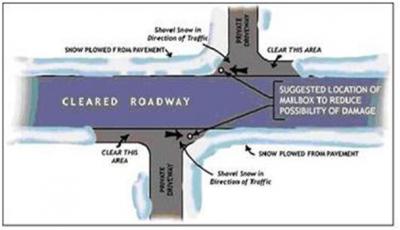
- Depositing snow in the roadway from your drive or walk is not only dangerous, it is illegal. If you have a contractor plow your drive, inform them not to push snow across the road. The “Cleared Roadway” diagram depicts the best way to perform your driveway snow removal to reduce the amount of snow that gets deposited into your driveway each time the plow goes by. By clearing the area just prior to your driveway, it allows the plow to “unload” before it reaches your driveway. Otherwise, mailboxes may be damaged during the winter. Many times the wing plow doesn’t hit the mailbox, but the snow coming off the wing does the damage.
- If the storm is of long duration, the crew continues around the clock until the job is done, many times working all day, night, and well into the next day with little or no rest. That truck you saw on your way home in the evening, is the same truck and Plow Operator you see in the morning on your way back to work. The Plow Operators do not get a shift change. Remember, they have been out there all night working to keep the roads safe. We are not in competition with surrounding towns to achieve the best roads. Each town has its own policy. We strive for the safest roads at reasonable costs in the shortest amount of time.
Winter Sand Pile
- The Winter Sand Pile for the Town of Durham is located at 1101 Hallowell Road, Durham, Maine.
- Town of Durham residents are allowed two (2) 5-gallon buckets per storm. Please remember to bring a shovel.
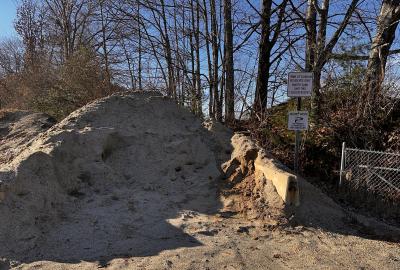
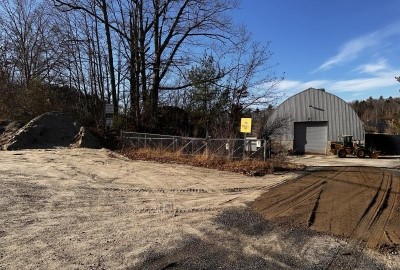
Restricting Vehicle Weight On Posted Ways
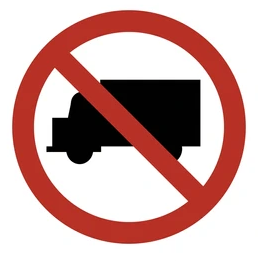
Section 1. Purpose and Authority
The purpose of this “Ordinance Restricting Vehicle Weight on Posted Ways” (hereinafter, the “Ordinance”) is to prevent damage to town ways and bridges in the Town of Durham which may be caused by vehicles of excessive weight, to lessen safety hazards and the risk of injury to the traveling public, to extend the life expectancy of town ways and bridges, and to reduce the public expense of their maintenance and repair. This Ordinance is adopted pursuant to 30-A M.R.S.A. § 3009 and 29-A M.R.S.A. §§ 2395 and 2388.
Section 2. Definitions
Except as otherwise provided herein, the definitions contained in Title 29-A M.R.S.A. shall govern the construction of words contained in this Ordinance. Any words not defined therein shall be given their common and ordinary meaning.
Section 3. Restrictions and Notices
The municipal officers or their designee may, either permanently or seasonally, impose such restrictions on the gross registered weight of vehicles as may, in their judgment, be necessary to protect the traveling public and prevent abuse of the highways, and designate the town ways and bridges to which the restrictions shall apply.
For permanent year-round restrictions: To regulate heavy trucks that are using these roads as a through-road rather than using them to access homes or as a delivery or pickup point along the roads, no person shall operate a vehicle with a registered weight (GVWR)in excess of 23,000 pounds on the following roads:
- Old Brunswick Road (starting from the southeasterly side of the intersection with Plummer Mill Road to the Quaker Meeting House Road)
- Shiloh Road
- Meadow Road
- Leighton Road
- Plummer Mill Road
The 23,000 GVWR restriction shall not apply to the permanently restricted list of roads above if the vehicle is providing a service to properties accessed by any of the listed roads. Nor shall the restriction apply to vehicles owned by places of business located on any of the foregoing roads whose normal business operations require the use of vehicles with a registered weight above 23,000 GVWR provided that the operation of any such vehicle complies with any notices issued by the municipal officers or their designee limiting their operation to a specific manner or to specific times. This exemption; however, shall not apply during the season of late winter and spring thawing period when they are posted with the annual temporary orange posters.
For the foregoing roads that have been permanently restricted, a sign post shall be erected upon which a sign displaying the maximum GVWR limit of 23,000 pounds shall be conspicuously posted at each end of the restricted portion of the way or bridge in a location clearly visible from the traveled way.
Whenever notice has been posted as provided herein., no person may thereafter operate any vehicle with a gross registered weight in excess of the restriction during any applicable time period on any way or bridge so posted unless otherwise exempt as provided herein.
For seasonal restrictions: To protect the town’s investment during thawing periods, pursuant to 29-A M.R.S.A. § 2395, the notice shall contain, at a minimum, the following information: the name of the way or bridge, the gross registered weight limit, the time period during which the restriction applies, the date on which the notice was posted, and the signature of the Road Commissioner. The notice shall be conspicuously posted at each end of the restricted portion of the way or bridge in a location clearly visible from the traveled way.
Whenever a restriction expires or is lifted, the notices shall be removed wherever posted. Whenever a restriction is revised or extended, existing notices shall be removed and replaced with new notices. No person may remove, obscure or otherwise tamper with any notice so posted except as provided herein.
Section 4. Exemptions
The following vehicles are exempt under State law: Any vehicle delivering home heating fuel or organic animal bedding and operating in accordance with a permit issued by the MDOT under 29-A M.R.S.A. § 2395 (4) and, when necessary during a period of drought emergency declared by the governor, any vehicle transporting well-drilling equipment for the purpose of drilling a replacement well or for improving an existing well on property where that well is no longer supplying sufficient water for residential or agricultural purpose and operating in accordance with a permit issued by the MDOT under 29-A M.R.S.A. § 2395 (4-A).
Frozen road exemption: This ordinance shall not apply to any restricted road which is solidly frozen. The highway is considered “solidly frozen” only when the air temperature is 32 F. or below and no water is showing in the cracks of the road (if paved). Alternatively, if the air temperature is 32 degrees F. or below and there is water showing in the cracks of the highway, the highway will be considered “frozen” if the adjacent gravel driveways, shoulders, or lawns remain frozen. On a gravel road, “solidly frozen” shall mean there is less than 1/4” of “thaw” on the gravel surface.
The following vehicles are also exempt under the specific provisions of this ordinance:
Any vehicle or combination of vehicles registered for a gross weight of 23,000 pounds or less.
Any vehicle or combination of vehicles registered for a gross weight in excess of 23,000 pounds and traveling without a load other than tools or equipment necessary for the proper operation of the vehicle. This exemption does not apply to special mobile equipment. It shall be a defense to a violation of this sub-section if the combined weight of any vehicle or combination of vehicles registered for a gross weight in excess of 23,000 pounds and its load is in fact less than 23,000 pounds.
Maine DOT vehicles or other vehicles authorized by Maine DOT or a municipality or county to maintain the roads under their authority.
Authorized emergency vehicles as defined in 29-A M.R.S.A. § 2054, school buses, a wrecker towing a disabled vehicle of legal weight from a posted highway, and vehicles with three axles or fewer under the direction of a public utility and engaged in utility infrastructure maintenance or repair.
Any two axle vehicles registered for a gross weight in excess of 23,000 pounds and less than or equal to 34,000 pounds that are carrying any of the Special Commodities may operate without a permit. Special Commodities includes any of the following:
- Home delivered heating fuel (oil, gas, coal, stove size wood that is fewer than 36” in length, propane and wood pellets);
- Petroleum products;
- Groceries;
- Bulk milk;
- Bulk feed;
- Solid waste;
- Organic animal bedding;
- Returnable beverage containers;
- Sewage from private septic tanks or porta-potties; or
- Medical gases.
Section 5. Permits
The owner or operator of any vehicle not otherwise exempt as provided herein may apply in writing to the municipal officers for a permit to operate on a posted way or bridge notwithstanding the restriction. The municipal officers or their designee may issue a permit only upon all of the following findings:
- no other route is reasonably available to the applicant;
- it is a matter of economic necessity and not mere convenience that the applicant use the way or bridge; and
- the applicant has tendered cash, a bond or other suitable security running to the municipality in an amount sufficient, in their judgment, to repair any damage to the way or bridge which may reasonably result from the applicant’s use of same.
Even if the municipal officers or their designee make the foregoing findings, they need not issue a permit if they determine the applicant’s use of the way or bridge could reasonably be expected to create or aggravate a safety hazard or cause substantial damage to a way or bridge maintained by the municipality. They may also limit the number of permits issued or outstanding as may, in their judgment, be necessary to preserve and protect the highways and bridges.
In determining whether to issue a permit, the municipal officers or their designee shall consider the following factors:
- no other route is reasonably available to the applicant;
- the current and anticipated condition of the way or bridge;
- the number and frequency of vehicle trips proposed;
- the cost and availability of materials and equipment for repairs;
- the extent of use by other exempt vehicles; and
- such other circumstances as may, in their judgment, be relevant.
The municipal officers or their designee may issue permits subject to reasonable conditions, including but not limited to restrictions on the actual load weight and the number or frequency of vehicle trips, which shall be clearly noted on the permit.
Section 6. Administration and Enforcement
This Ordinance shall be administered by the Road Commissioner.
Section 7. Penalties
Any violation of this Ordinance shall be a civil infraction subject to a fine payable to the Town of Durham of not less than $250.00 for the first offence and $500.00 for each subsequent offense. Each violation shall be deemed a separate offense. In addition to any fine, the municipality may seek restitution for the cost of repairs to any damaged way or bridge and reasonable attorney fees and costs. Prosecution shall be in the name of the municipality and shall be brought in the Maine District Court.
Section 8. Amendments
This Ordinance may be amended by the municipal officers at any properly noticed meeting.
Section 9. Severability; Effective Date
In the event any portion of this Ordinance is declared invalid by a court of competent jurisdiction, the remaining portions shall continue in full force and effect. This Ordinance shall take effect immediately upon enactment by the municipal officers at any properly noticed meeting.
(Back to top)